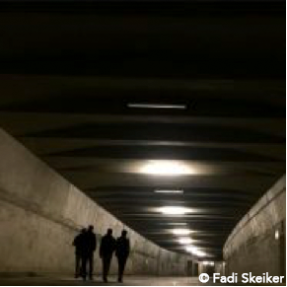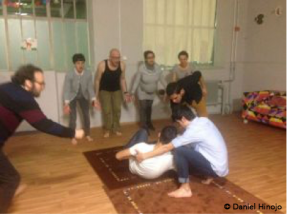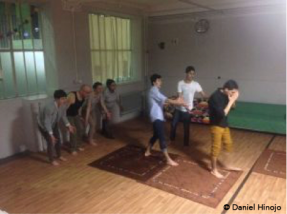I am in the same room with three young asylum seekers from Syria – Abed, 17, from Deir al-Zour; Mohamad, 16, from Marj al-Sultan; and Odai, 17, a Palestinian who was born and raised in Syria. The three of them have come from Syria on death boats, and the three of them are interested in theater. I look at their eyes and I see determination, bravery, and hope.
Thanks to Alexander Shroeder, a theater professor and an avid theater maker from Berlin, I was able to lead an applied theater workshop with three core members of his new theater company, one that is formed by youth refugees who are temporarily located in Berlin’s Tempelhof airport. Tempelhof, which was largely built by the Nazi government, ceased its airport operations in 2008 and has now become a refugee center with a plan to house up to seven thousand refugees, turning it into one of the biggest if not the biggest refugee centers in Germany.
Alexander’s work with the three youth and others started in late winter 2016, when he began working with them with the assistance of Raghda, a translator, to use theater as a tool to address their issues, their lives, their trip to Germany, and their dreams. Alexander is for them more than a theater facilitator, he is a mentor, a big brother, and a bridge between them and the German community.
I look at them and I know they are all ready to share, before even starting the workshop. One of them starts telling me his story. He went on a floating boat from Turkey to Greece before he walked his way to Germany. His boat was busted a couple of times by coast guards before he was able to arrive in Greece. Abed, the other boy, was lucky to arrive in Greece after only one attempt. Odai was detained and tortured in Syria before he decided to run away. They are already sharing their stories while we are taking our shoes off, before we start the workshop, and I am thinking, “I came here so that I can listen to their stories and they are already sharing them, what to do next?”
Alexander joins us accompanied by three German enthusiasts who are curious to meet and support these three kids. I look at two German women and one German man entering the room, and I feel that it will not be comfortable leading a workshop with three participants while four are observing. I make a decision to include everyone in the room in the workshop, including Raghda, the translator. The Germans put their shoes away and we all stand in a circle. Until now, I am not sure what to do, as my plans as a theater facilitator are constantly changing.
I start by asking everyone in the circle to breathe, to hum. The humming sound gets louder while I ask them to move their bodies while they are still humming. I ask them to create a circle, coming close then drawing away, while feeling the group energy. We stand in a circle again, and I vocalize sounds with different variations, while the group imitates me. While doing these group exercises, I aim to create a connection between the different bodies in the room, the Syrians and the Germans. The connection at this point is a basic human connection, as all humans regardless of race, color, or national origins have a body and a voice; most human beings can move his/her body in walking, and most can vocalize. While I do the physical/vocal routine, I start to be more daring little by little, making the movements more sharp, and doing a vocal variation that is unusual. I feel that the group is accepting of my proposals and that I am not facing any kind of resistance, which encourages me to move to the next step. Each one will lie down and each one will put her/his hand on her/his stomach and feel the warmth between the hand and stomach, feeling the tiniest movement of the hand going up while she/he is breathing in and breathing out.
I ask them to notice the smallest movement they feel in their bodies and exaggerate it. The movement is getting bigger and the body travels in the room while I put on music. I ask each one to say what they see while they move. Odai sees Khan al-Sheeh, Mohamad sees Marj al-Sutan, and Abed sees Daraa – each of them sees their hometowns in Syria. I ask them to move their bodies while they vocalize what they see. I feel now that as the workshop starts, it is not important at this moment to tell their stories since they have already shared them with me. What they need at this moment is to express, to re-live and re-embody fractions of their memories so that they can try to come to terms with their current situations.
Each one of them stands and says his name and where he is from while moving the body in a way that is expressive and in harmony with his name and where he is from. The rest of the group, including the Germans, would imitate Odai, Abed, and Mohamad. Mohamad, for example, says his name and his town of origin once and the Germans repeat it after him. Mohamad’s eyes glitter with joy while he is feeling that a group is actually for a second trying to be him.
At this point, I feel they are ready to go even deeper. I ask them to imagine that the hall we are in is a boat and the participants have to keep moving, yet to balance this boat by moving to any empty space and occupying it with their bodies. While moving to balance the boat, I ask them to say any word that is related to their imagined boat. Mohamad could not wait to say, “help me.” I ask him to keep repeating “help me” in different vocal variations while the group is repeating after him saying, “help me” in the same vocal variations as Mohamad.
Odai looks at me indicating that he has another word. I ask him to say the word in his mind, and he bursts out with the word “gharage,” which means “it drowned” in Arabic. Abed waits until he is given the opportunity to say his word, and in English this time, it is “Oh my God.”
We sit in a circle and the three brave youth share what they see/feel in relationship to their experiences: We are on the same boat, in the middle of the sea, the boat is about to capsize, coastal guards are within vision but they are not helping them, they keep calling “help me, help me.”
During my extensive work with refugees leading a plethora of workshops within similar contexts, I’ve started to see a pattern for most of the boat stories I have heard: refugees find their way to Turkey; they contact a smuggler; they are housed somewhere close to the sea; and they make “mohaoleh,” which means an “attempt” to cross the sea to Greece. If they are lucky, they arrive in Greece on their first attempt, but if they are not lucky, they get caught and return to Turkey and keep trying it again and again until they reach Greece. This sounds easy, but the reality is harsh. People, while they wait close to the sea, stay for maybe days crammed in small apartments, which ten of them might be sharing.
Until they get a call from the smuggler to go to the sea, they are not allowed to leave the apartment for two reasons: (1) the Turkish police might suspect that they are potential asylum seekers – the Turkish police actually busted some of these apartments – and (2) these souls are actually on alert, meaning that at any minute, the smuggler could tell them the car is down there and they need to go to the sea now. The smugglers will usually provide people with fast food and water while they are crammed in these small apartments. Out of the stress and the crowdedness in these apartments, many people opt out of showering and using toilets. They feel that it will be all over when they get a call from the smuggler to head to the sea. When they finally get the call – it might be 2:00 a.m. or 3:00 a.m. – they are dragged to a car down from the building and off to the sea. An episode ends and a new episode starts. They arrive at the sea and they wait and wait until they get an “okay” from the smuggler to go on the boat. When I say they wait, I am talking here about hours, maybe a day or two. At this point, they lack food, water, and a bathroom or a toilet. At this point, the boat, which is supposed to be the most dangerous part of their trip, is for them a salvation – they can’t wait until they get a notification to go on it.
They are on a boat now. An episode ends and a new episode starts.
The media has been selective in providing us – those who are seated comfortably on our couches – with only one part of the story, the boat story, while ignoring the part of the trauma that led them to the boat. Perhaps this is because the boat story is more sensational since it contains potential drowning, death, crying women, crying children, the bright colored lifesaving vest, etc. It is way more sensational than covering crammed people in small apartment waiting for a signal from the smuggler.
Let’s skip the boat trip – the epic trip through Europe until reaching Germany or another country that promises a roof, a meal, and hope for a better future. Refugees now are under a different kind of stress. They are in Germany and are waiting for their paperwork to be processed. They wait and wait and wait. Crammed in a refugee center, all that they care about is receiving a post, a letter from the authority that will inform them about their legal status. While waiting, they are not engaged in any meaningful sustainable activities, they are in a waiting zone, where they wait and wait and wait for weeks, for months, and maybe even years. A reasonable percentage of those asylum seekers are university degree holders, workers, and people who are eager to start getting integrated in their host community to be active parts of it. They are eager to learn and to work, but instead, they have to wait, wait, wait. While they are waiting, they pass their time on activities such as the one Alexander is doing voluntarily; in his case, creating theater classes, and maybe a theater company.
We are back to Tempelhof, me with them in a room, breathing and playing games that for a minute can capture their harrowing experiences. I ask them to create three frozen images while I divide them into two groups: a group made up of the three asylum seekers, and a group made up of the Germans. The three images that come out of the Syrians are the following: the first one is someone injured in the street and two others are helping. The second image is of one person departing while the other two are sad for his departure. The third image is of one person dancing and the other two are looking at him in amusement.
The three scenes are images that the three youth have seen, and it chronologically charts their stories. They had to deal with war and violence in Syria, as in the first image. They make a decision to leave and risk their lives to arrive to Europe, as in the second image, and they finally arrive to see someone dancing in the street in Germany. The German group creates three frozen images that depict their sadness and shock to hear and see the Syrian stories. I ask both of the groups to create combined images where they all create their images simultaneously in slow motion. They do that in a solemn way, very simple, very poetic, and very telling.
At the end of the workshop, I ask where to go from here: Mohamad wants to be a pilot, Odai wants to be a policeman, and Abed wants to be a theater actor. It is amazing to see how easy it is for them to articulate their dreams. They do feel that dreams now are to be achieved. Their path, even though hard, is still clear. As they put it, “you learn the language, you go to college, and you do what you want. Yes, the situation in the camp now is hard, but it is a phase; yes, learning a new language is hard, but we will make it; yes, we face people who do not want us to be here, but our dreams are wide open and when people see us achieving what we want, they will change their attitudes about us.”
I am still in the same room with the three young asylum seekers from Syria – Abed, 17 years old from Deir al-Zour; Mohamad, 16 years old from Marj al-Sutan; and Odai, a 17-year-old Palestinian who was born and raised in Syria. I look at their eyes, and I see determination, hope, and resilience. Changing the course of their lives was not easy, is not easy, and will not be easy, but it all starts with visualizing, imagining, and articulating their dreams. They seem to be able to do that, and I am sure their dreams are yet to be achieved.
This article was first published in South Writ Large: Stories, Arts, and Ideas from the Global South.
Fadi Fayad Skeiker is currently a visiting scholar at the IRC.




